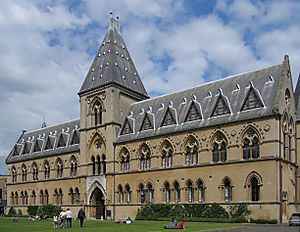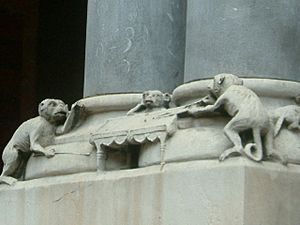Benjamin Woodward facts for kids
Benjamin Woodward (born November 16, 1816 – died May 15, 1861) was a talented Irish architect. He worked with Sir Thomas Newenham Deane. Together, they designed many important buildings. You can find their work in cities like Dublin, Cork, and Oxford.
Contents
About Benjamin Woodward
Early Life and Training
Benjamin Woodward was born in Tullamore, County Offaly, Ireland. He first trained to be an engineer. However, he became very interested in old buildings from the Middle Ages. He even made detailed drawings of a place called Holy Cross Abbey in County Tipperary. These drawings were shown in London in 1846.
Working with Thomas Deane
In 1846, Woodward started working for Sir Thomas Deane. By 1851, he became a partner in the business. Deane's son, Thomas Newenham Deane, also joined them. It seems that Sir Thomas Deane handled the business side. Woodward was the main person in charge of designing the buildings.
Famous Buildings He Designed

Woodward designed several important buildings. Two of his most famous works are the Museum at Trinity College, Dublin (built 1854-1857) and the Oxford University Museum of Natural History in Oxford (built 1854-1860). He also designed the Kildare Street Club in Dublin (built 1858-1861). Another key building was Queen's College Cork (built 1845-1849), which is now known as University College Cork.
Special Decorations and Carvings
The buildings designed by Deane and Woodward are known for their beautiful, natural-looking decorations. You can see plants and animals carved into the stone around windows and doors. A famous writer named John Ruskin loved these carvings, especially at the Trinity College Museum.
Woodward worked closely with two brothers, James and John O'Shea. They were skilled stone carvers from County Cork. The O'Shea brothers, along with other sculptors, created many detailed stone carvings at Trinity College. These carvings show owls, lizards, cats, monkeys, and many different plants.
Later, the O'Sheas also carved stone at the Kildare Street Club. One very famous carving there shows club members as monkeys playing billiards!
Inspiration and Teamwork
Woodward shared John Ruskin's idea that buildings should be inspired by nature. He wanted the Oxford Museum to bring back the old Gothic style. This style used natural symbols to decorate buildings. Woodward believed in letting his skilled carvers, like the O'Shea brothers, use their own ideas. This was similar to how stonemasons worked in the Middle Ages.
Even though Woodward was ill, he was a very inspiring person in Oxford. Many artists admired him, including Gabriel Rossetti and William Morris. While in Oxford, he also designed the new Oxford Union building. This is where famous artists later painted frescoes.
Woodward brought a team of carvers and stonemasons from Ireland. They lived in a special camp built at the museum site. This camp even had a reading room and a lecture hall. John Ruskin himself spoke to the workers there. He talked about his ideas for Gothic architecture and how important the ordinary craftspeople were in creating it.
The O'Shea brothers were perfect examples of these artist-craftsmen. They were very talented and their natural way of carving fit perfectly with Ruskin's vision. People remembered how the "handsome red-bearded Irish brothers Shea" would bring plants from the Botanic Garden each morning. Soon after, these plants would appear carved into the stone pillars of the museum.



